(function() {
document.addEventListener('DOMContentLoaded', function() {
var componentMetadata = JSON.parse('\x7b\x22componentName\x22\x3a\x22ActionToolbar_d4f0b4cc-dd76-4537-857b-56997525ceb8\x22,\x22deferOptions\x22\x3a\x7b\x22deferComponent\x22\x3atrue,\x22deferType\x22\x3a\x22OnDemand\x22,\x22deferId\x22\x3a\x22r3ec336a3f55441898ddec15045ac8f24\x22,\x22deferredContainerId\x22\x3a\x22\x2ffloatingActionToolbar\x2ffloatingActionToolbar_Interop\x22,\x22deferredContainerView\x22\x3a\x22InteropDeferWrapper\x22\x7d,\x22viewName\x22\x3a\x22ActionToolbar\x22\x7d');
var configuration = {"contentId":"9aeb7603-04fc-47a4-bc68-0c774fa8bf70","toolbarSettings":{"id":"d4f0b4cc-dd76-4537-857b-56997525ceb8","regAction":"FAVORITE","eSourceCode":16797,"namePassedToEvents":"ArticleStandardLongFormToolbar","buttons":[{"providerName":"pinterest","providerNamePassedToEvents":"Pinterest","shareUrlFormat":"//pinterest.com/pin/create/link/?url={0}","id":"76def9a1-42e6-4e8d-b963-2bb41556cef1","allowedForAnonymousUsers":true,"type":"Social","displayName":"Pinterest","toggleDisplayName":"","namePassedToEvents":"Pinterest","cssClassName":"atButtonPinterest","privacyOptOutMessage":"\u003cdiv class=\u0027privacyMessage\u0027\u003e\n\u003ch3\u003eThis feature is not available with your current cookie settings.\u003c/h3\u003e\n\u003cp\u003eYou can \u003ca href=\u0027#\u0027 data-show-preference-center=\u00271\u0027\u003eupdate your privacy settings\u003c/a\u003e to enable this content. Please enable “Functional Cookies” to use this feature.\u003c/p\u003e\n\u003c/div\u003e","showPrivacyOptOutMessage":false},{"addFavoriteErrorMessage":"Sorry, something went wrong. Please save again.","removeFavoriteErrorMessage":"Error occurred while removing from favorites","regAction":"FAVORITE","eSourceCode":16797,"isCurrentUserAnonymous":false,"isFavoriteItem":false,"id":"718b4e01-b2be-40cf-8f0c-bca3b01db0ed","allowedForAnonymousUsers":false,"type":"Favorite","displayName":"Save","toggleDisplayName":"Saved","namePassedToEvents":"Favorite","cssClassName":"atButtonFavorite","privacyOptOutMessage":"\u003cdiv class=\u0027privacyMessage\u0027\u003e\n\u003ch3\u003eThis feature is not available with your current cookie settings.\u003c/h3\u003e\n\u003cp\u003eYou can \u003ca href=\u0027#\u0027 data-show-preference-center=\u00271\u0027\u003eupdate your privacy settings\u003c/a\u003e to enable this content. Please enable “Functional Cookies” to use this feature.\u003c/p\u003e\n\u003c/div\u003e","showPrivacyOptOutMessage":false},{"providerName":"facebook","providerNamePassedToEvents":"Facebook","shareUrlFormat":"//facebook.com/sharer/sharer.php?u={0}","id":"efdb520e-282a-4ae1-8a04-1d444442d622","allowedForAnonymousUsers":true,"type":"Social","displayName":"Facebook","toggleDisplayName":"","namePassedToEvents":"Facebook","cssClassName":"atButtonFacebook","privacyOptOutMessage":"\u003cdiv class=\u0027privacyMessage\u0027\u003e\n\u003ch3\u003eThis feature is not available with your current cookie settings.\u003c/h3\u003e\n\u003cp\u003eYou can \u003ca href=\u0027#\u0027 data-show-preference-center=\u00271\u0027\u003eupdate your privacy settings\u003c/a\u003e to enable this content. Please enable “Functional Cookies” to use this feature.\u003c/p\u003e\n\u003c/div\u003e","showPrivacyOptOutMessage":false},{"templateId":"ec5776a6-84cf-4f91-ba79-ace5d6ae2fa2","dialogHeading":"Email Article","emailCode":"TBSP_ContentEmail","dialogSettings":{"cancelButtonText":"Cancel","copyToSenderLabel":"Send a Copy to Myself","emailAddressesLabel":"* Email Address(es)","emailInstructionText":"Separate email addresses with commas","fromText":"From:","privacyPolicyText":"\u003cp\u003e\u0026copy;2025 General Mills, Inc. All Rights Reserved. This information will only be used to send an email to your friend(s) and will not be saved. Please read our \u003ca rel=\u0022noopener noreferrer\u0022 rel=\u0022noopener noreferrer\u0022 href=\u0022http://www.generalmills.com/company/privacy-policies/privacy-policy-us\u0022 target=\u0022_blank\u0022 shape=\u0022rect\u0022\u003ePrivacy Policy\u003c/a\u003e.\u003c/p\u003e","requiredFieldText":"* Required","sendButtonText":"Send","senderEmailAddressLabel":"* Your Email Address","senderFirstNameLabel":"* Your First Name","sendToText":"Send To:"},"id":"1b476610-b2bd-4a56-ba87-47a4798f6dcb","allowedForAnonymousUsers":true,"type":"Email","displayName":"Email","toggleDisplayName":"","namePassedToEvents":"Email","cssClassName":"atButtonEmail","privacyOptOutMessage":"\u003cdiv class=\u0027privacyMessage\u0027\u003e\n\u003ch3\u003eThis feature is not available with your current cookie settings.\u003c/h3\u003e\n\u003cp\u003eYou can \u003ca href=\u0027#\u0027 data-show-preference-center=\u00271\u0027\u003eupdate your privacy settings\u003c/a\u003e to enable this content. Please enable “Functional Cookies” to use this feature.\u003c/p\u003e\n\u003c/div\u003e","showPrivacyOptOutMessage":false},{"layoutParameter":"p%3d1","id":"ab4bf4fc-919a-4252-81ca-c39edb8eadf0","allowedForAnonymousUsers":true,"type":"Print","displayName":"Print","toggleDisplayName":"","namePassedToEvents":"Print","cssClassName":"atButtonPrint","privacyOptOutMessage":"\u003cdiv class=\u0027privacyMessage\u0027\u003e\n\u003ch3\u003eThis feature is not available with your current cookie settings.\u003c/h3\u003e\n\u003cp\u003eYou can \u003ca href=\u0027#\u0027 data-show-preference-center=\u00271\u0027\u003eupdate your privacy settings\u003c/a\u003e to enable this content. Please enable “Functional Cookies” to use this feature.\u003c/p\u003e\n\u003c/div\u003e","showPrivacyOptOutMessage":false}],"isSticky":true},"userSettings":{"isCurrentUserAnonymous":true,"isFavoriteItem":false,"isAnonymousUserWithFavorites":false},"pageAttributes":{"url":"https%3a%2f%2fwww.tablespoon.com%2fposts%2fhow-to-plate-like-a-chef","contentId":"9aeb7603-04fc-47a4-bc68-0c774fa8bf70"},"recaptchaPublicKey":"6LfW_icUAAAAAL_CG700pddUxLNYIxgRJe3vOg2Z"};
var moduleName = 'actionToolbar';
var isVueModule = true;
GeneralMills.PandoSites.RegisterControlInstance(moduleName, configuration, componentMetadata, isVueModule)
});
})();
Introduction
We’ve all done it while dining out. The server places a beautifully arranged plate in front of you and it’s not the fork you grab first—it’s your phone so you can snap a pic of that perfectly plated food. It’s pretty clear, in this day and age, the way your food looks is just as important as how it tastes.
So if you consider yourself a bit of a gourmand and love throwing dinner parties, there’s one crucial step that can help elevate your meal from great to amazing. We’re talking plating. From choosing the right ingredients, to the type of plate you use, we’ll help make your food look Instagrammable. So, channel your artistic side and we’ll show you the basics on how to plate food like a professional chef.
How to Choose Which Ingredients Go Well Together
The first step to plating is choosing the ingredients. It’s important when creating a visual to not only consider ingredients that go together but also foods that look good together. You eat with your eyes first, so choosing your ingredients is a crucial step.
Step 1: Color Scheme
Color is very important to a perfect plate. A monochromatic meal is boring to look at and definitely won’t make you hungry. Plates that include a variety of bright colors are much more stimulating to the appetite.
But what if the food you’re plating is a drab color? Adding fresh herbs, salad greens and even edible flowers will introduce pops of color and contrast that create visual interest—like the parsley, tomato and onion on top of this Cold Cucumber Soup:
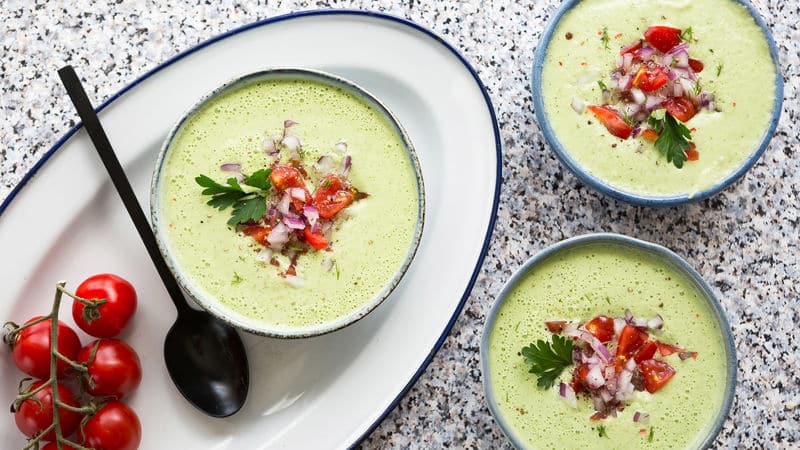
Here are our best practices for choosing colorful ingredients for your plate:
- Use fresh ingredients.
- Avoid a monochromatic color scheme.
- Look for vegetables in unexpected colors (multicolored carrots, orange or purple cauliflower, purple potatoes, etc.).
- Plan ahead. Try to think of all the colors you’d like to include in your meal. Taking stock of what you’ll be serving beforehand will give you a chance to find opportunities for bits of color.
- Never underestimate the power of a sprinkle of fresh herbs.
Step 2: Height
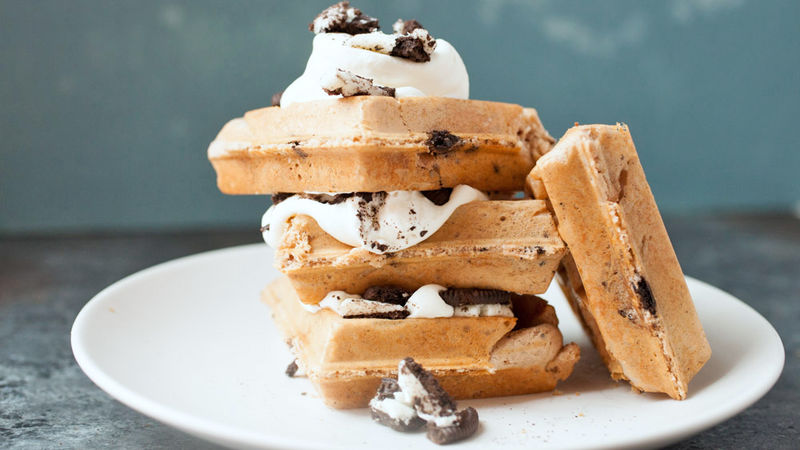
Besides color, another key element in plating is height. Think up, not just out. Layering and stacking food can add a lot of dimension and excitement to a plate. These Cookies and Cream Waffles look delicious stacked high, and the one piece leaning against the stack adds even more interest and fills the space on the plate.
Here are our best practices for adding dimension:
- Lean or stack ingredients against each other.
- Place items on top of each other, like proteins on top of starches (such as steak on top of mashed potatoes).
- Sauces can be used as a base layer of color on the plate, with the rest of the food placed on top.
- Height is another dimension for filling space, and can make food look bigger. Try stacking veggies or salads.
Step 3: Garnish
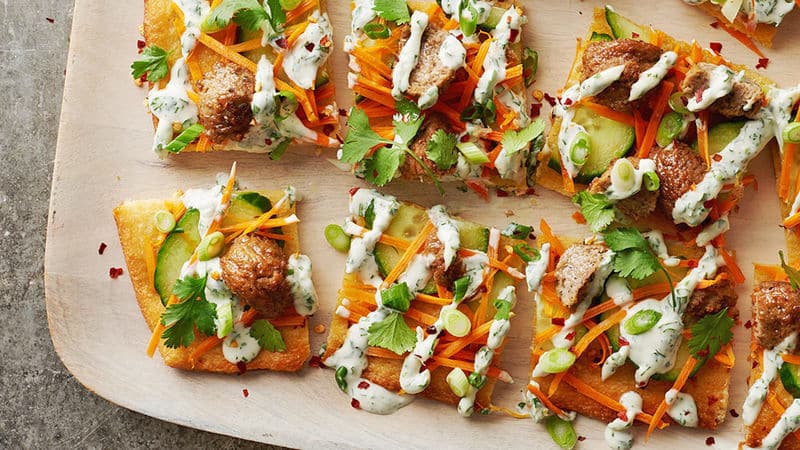
While the food is the main event, the garnishes can make a huge difference in the overall look and taste. Here are our best practices for picking the perfect garnish to your plate:
Flavor matters! Enhance the taste of the food, don’t fight it.
- Use fresh herbs to add a pop of color and aroma. Parsley is a go-to choice; we also like dill, chives, mint or cilantro (used above to garnish a Bahn Mi Flatbread.
- Add citrus in the form of zest or delicate twists.
- Add creative and surprising garnishes like berries or spices.
- Sprinkle on fresh edible flowers.
- Most importantly, don’t clutter the plate with garnishes. A light sprinkling is better.
Best Tools for Plating Food
One of the best parts of plating is in the decoration. Having a few special tools on hand will help you create your vision and elevate a plate from drab to dazzling. Tools like long thin tweezers are a chef’s best friend for purposefully placing tinier items.
Squeeze bottles are helpful when you want to add perfect drops, or lively drizzles of sauces and condiments.
Or, grab a brush and paint on a streak of sauce (how fancy does this hot dog look?):
You can even use a regular spoon too. Place a puddle of sauce (works best with thicker sauces) on the plate, and drag the back of the spoon through the sauce in one, swift movement. The lines and shapes will add movement and visual interest.
If you have a spiralizer or julienne peeler, you can enhance the presentation of even the simplest components, like the carrots on top of these Deconstructed Egg Roll Noodle Bowls:
And don’t forget your trusty knife. Simply cutting your fruits or vegetables into unusual shapes can add something new and fun to the plate.
The key though is to not get too obsessed with making it look perfect. A bit of controlled messiness will feel more balanced and visually enjoyable than something rigid. Offset straight lines with something round and vice versa. Combine and contrast. Play around with asymmetry. Let the food land naturally when sprinkling something onto the plate. It will all feel more balanced and less fussy.
How to Change the Color of Food
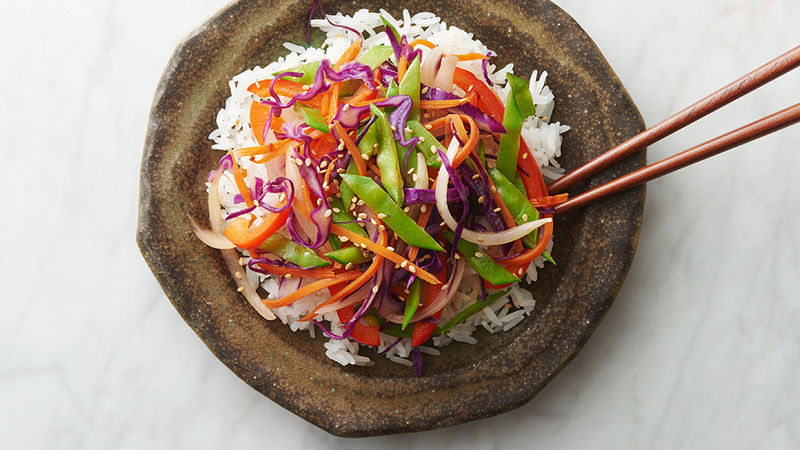
The brilliance of cooking is that it can transform food’s color, texture and shape. Thinking of cooking as not only a way to prepare your food for consumption, but also as a way to alter it visually will help your plating style. Here are a few tips for getting the best colors from your food when you cook it:
- Lightly cooking vegetables will actually enhance their color while overcooking will not only turn your veggies into mush, they’ll look like mush too. Simply steaming can bring out bright, vivid greens in vegetables like broccoli or asparagus. Or a quick boil then blanching (shocking vegetables in an ice bath to stop cooking and preserve the color) will do the same trick.
- On the other end, roasting creates gorgeous golden tones from the caramelization. Onions, carrots, cauliflower, all look great (and taste amazing) when roasted.
- For meats or fish, searing is your secret weapon. Searing adds a crispy, brown exterior to any protein and is much more appetizing to the eye.
- Frying foods can add a lovely golden color to the plate as well as texture. Be careful not to under fry (too light) or over fry (too dark). And make sure to drain any fried foods on a paper towel to remove excess oil. A greasy-looking plate is definitely not pretty.
How to Pick the Perfect Plate
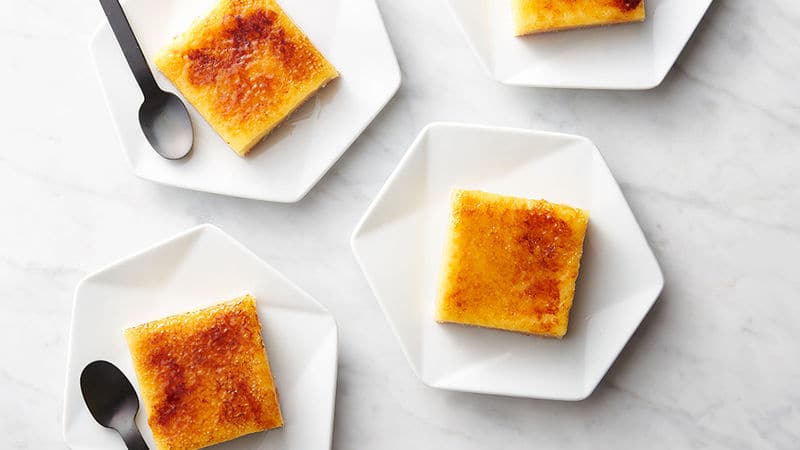
When it comes to plating, it’s not just about the food, but the plate you’ll be placing the food upon, too. While color is probably the most important, shape and size can affect the overall visual when plating food too.
When it comes to size you need to find a comfortable balance. Too large and the food will look skimpy. Too small and it will feel crowded.
If you’re new to plating and styling food, it’s easiest to keep it simple with plates that are white, ivory or other light shades. This way you can focus on getting confident with positioning different elements, embellishing with sauces or garnishes, and balancing amounts of empty and filled space on your plate.
That said, don’t be afraid to experiment. As you become more comfortable with plating, start playing around with colors and patterns of your dishes. A geometric shape can make even a white plate interesting, and a darker or brightly colored plate can create striking contrast that elevates the look of your food.
How to Plate Food Like a Chef (You Can Do It!)
This feature is not available with your current cookie settings.
You can update your privacy settings to enable this content. Please enable all cookies to use this feature.
Now that you’ve got the essential elements to plating, let’s put it together! Here is a step-by-step on how to plate food.
What You Need:
- A white or ivory plate
- Any tools you’ll need: Spoons, knives, ladles, tongs, squeeze bottles, brush, tweezers, etc.
- Clean rag or paper towel
Step 1: First, try to picture all the components (sides, main, garnishes) together as one cohesive item. Finding balance through symmetry—or asymmetry—in relation to your main item will make a huge difference. Where will you place the vegetables in relation to that piece of steak or chicken? How will the sauces be presented?
Step 2: For a basic plating idea, place the main item in the center of the plate, then build around it. Keep the amount of food on the plate to a minimum, filling only about two-thirds of the plate at most. Allow for white space.
Step 3: Play around with all of the elements until you have a cohesive and balanced plate, combining textures, adding color, mixing flavors and building height.
Step 4: Add drizzles or swirls of sauces and condiments, as well as any garnishes.
Step 5: Present a clean plate by wiping down the edges with a clean rag or paper towel.
How to Take the Perfect Picture of Your Food
You’ve got the plating perfected; now you need the proof. Here are a few steps to taking gorgeous, instagram-worthy pictures of food.
Here are all our dos and don’ts for taking the perfect picture of your food:
- Don’t use the flash. If it makes people look terrible in pictures, it’s even worse for food.
- Shoot from an above angle or looking directly into your food at eye level.
- Natural lighting is best.
- Avoid unnecessary filters on whatever smartphone app you’re using to edit your photos.
- Check out other food bloggers or cooking magazines for photo tips and inspiration.
Other Tips & Tricks for Plating Food
Now that you’ve learned the basics, here are a few more tips and tricks for plating food.
- Always plate in odd numbers.
- Give it a quick spritz of oil or water if the food is starting to dry out.
- Mix and match textures.
- Pour broths or sauces over the rest of the soup or stew ingredients right before serving.
- If serving pasta, twist the pasta into a nice round pile instead of spread out on the plate or bowl.
- Don’t have a squeeze bottle? Use a plastic bag and snip the tip from a corner. Works great!
- And remember to check out food magazines or other resources for the latest food styling trends. Much like other creative industries, trends come and go fast.
While it sounds like there are a lot of rules to perfect plating, the most important is to be creative and enjoy your meal! So, grab a plate and bon appetite!
Become a kitchen expert with our how-to tutorials.